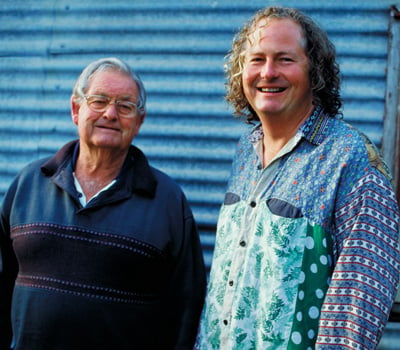Jasmine Hirsch never believed she’d end up working with her father, David, at Hirsch Vineyards on Sonoma’s remote far coast. Olivier Berrouet didn’t have a second thought when he was offered the job his father, Jean-Claude, had held for more than forty years—making the wine at Château Pétrus in Bordeaux. Working with—or separately from—a famous father may not be the simplest career path—but the sons and daughters in the pages that follow have worked it out brilliantly.


Osborn’s father, d’Arry, never had any formal training in wine. He grew up around the vines his grandfather had bought in 1912 and the tin shed winery his father had built in 1928. He put his mother’s family name on the label, along with a red stripe, and brought out his first bottling of d’Arenberg Burgundy in 1959, now an Australian classic known as d’Arry’s Original.
Chester started working “in the holidays” when he was seven. “I got paid ten cents an hour,” he recalls, “picking grapes, working on the bottling line. The next year, I got a raise to 30 cents.” Back then, the lineup included a Claret, a Shiraz-Cabernet blend and later a Shiraz Pressings his father first made in 1979, a wine that would become Ironstone Pressings, which Chester now makes with some grenache in the blend.
Proving the success of his mother’s brainwashing technique, Chester studied enology. “When I returned from Roseworthy, my dad said, ‘You make the wine,’” Chester recalls. That was 1984. “I had no idea what I was doing. They taught us winemaking, but without any grapes—it’s like going to art school with no paint.”
The first things Chester changed were the whites. His father was fermenting whites like palomino, riesling and chenin on the skins. “As soon as I got home, I said ‘No,’ and crushed them straight into tank, fermented cold and slow. After the vintage, I lined up all the wines for my father to look at, and he said, ‘Oh, they’re much more fruity than before.”
Chester spent the next six months traveling with friends in Europe, visiting four wineries a day. “My father thought when I returned I would change the whole winery” he says. “It was quite old fashioned. Even the lizards couldn’t survive the old crusher. The first thing I bought was in 1989—a Demoisy crusher, an amazing crusher in those days. The lizards came out of it alive. But mostly I ended up going further back into the old ways. Back to foot treading.”
Over the years, d’Arry and Chester haven’t always agreed on winemaking style. In the 1990s, when picking grapes at higher levels of ripeness came into vogue, Chester started pushing the boundaries. “I remember my father telling me I was picking too ripe,” Chester says. “And he was right. Now I’ve pulled back. We’re trying to make wines with more fragrance, more mineral, wines that will age slowly.”
Now, as d’Arry and Chester prepare for their vineyard’s 100th anniversary, they’ve created a new range of wines—14 site-designated shiraz from the 2010 vintage, to be released next year. Chester sees it as a way to keep tabs on individual blocks over time. He himself is no longer on an hourly wage, but after a lot of sweat, he has yet to gain equity. D’Arry owns the majority of d’Arenberg, with his brother and sister splitting the rest. “One day, if I’m nice,” Chester says, “I might get in the will.”
TOP-PERFORMING WINES
91 ‘08 McLaren Vale The Cadenzia $29 (10/10)
91 ‘08 McLaren Vale The Custodian Grenache $19 (10/10) (Old Bridge Cellars, Napa, CA)
This story was featured in W&S Fall 2011.
Joshua Greene is the editor and publisher of Wine & Spirits magazine.
This story appears in the print issue of fal 2011.
Like what you read? Subscribe today.
















